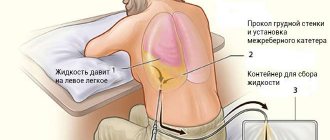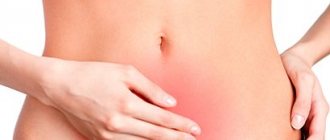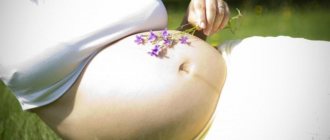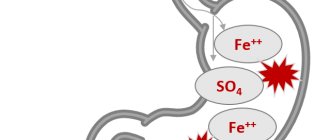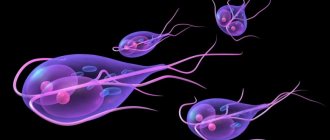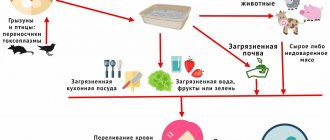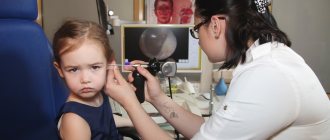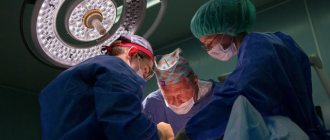Symptoms and clinical picture of ascariasis in children
If the number of worms entering the body is small, the disease may occur in an unexpressed form.
At an early stage, the following manifestations of ascariasis in children may be observed (associated with the penetration of larvae into the lungs and liver):
- deterioration in general health;
- temperature rise to 38 C;
- heavy sweating;
- pain in muscles and joints;
- nausea, vomiting, loss of appetite;
- swelling of the eyelids and face;
- cough is dry or with mucous sputum streaked with blood;
- difficulty wheezing, wheezing;
- chest pain;
- dyspnea;
- suffocation;
- allergic reaction (urticaria);
- skin itching;
- enlargement of lymph nodes, liver and spleen.
Symptoms of ascariasis in children at the second stage - intestinal:
- bloating and flatulence, pale skin or mild jaundice,
- abdominal pain, most often in the umbilical area,
- constipation or loose stools, weight loss.
Further development of the disease leads to a significant weakening of the immune system and the development of serious complications.
Causes
The cause of ascariasis is the introduction of helminth eggs into the gastrointestinal tract. The source of infection is a sick person. It releases ascaris eggs with feces, which fall into the ground and mature there. This requires suitable climatic conditions: temperature, humidity, air circulation. There is a correspondence between the rate of development of larvae in the egg and temperature:
- 15-30 °C – ripening occurs in 9-42 days;
- 24-30 °C – 16-18 days.
At temperatures below 12 °C, eggs do not develop, but they are able to wait out an unfavorable period, while they remain viable throughout the year.
Transmission routes
The transmission mechanism is fecal-oral. It is carried out through household items, water or food products. A child can become infected after eating unwashed vegetables, fruits or poor-quality drinking water. Children play in the sandbox, garden, and playgrounds. There they contaminate their hands, which also become a transmission factor.
Ascariasis is more common among residents of rural areas. People suffer from it throughout the year, but a significant number of cases are observed in the fall, when berries and vegetables ripen. In winter, they are stored in pantries and cellars, where favorable conditions for the maturation of eggs are also created.
Characteristics of the pathogen
Ascaris parasitizes not only humans, but also pigs. This worm is yellowish-red in color, but after death it turns white. It is similar in shape to a spindle, the body length is different in females and males. The former are much larger (25-40 cm in length) and can lay up to 250 thousand eggs. The lifespan of one individual is 1 year. Parasites are classified as geohelminths due to the need to mature in the soil.
Migration of roundworms
The appearance of roundworm eggs in the intestines is the first stage of the disease. The larvae are released from their shells and enter the blood vessels, through which they are transported to the liver and lungs. Other localizations are also possible: eyes, brain, kidneys, but they occur less frequently. In the lungs, through small bronchioles and alveoli, the larvae enter the respiratory tract, rising to the pharynx. There they are reintroduced into the digestive tract. Migration lasts about two weeks. Then the larvae fully develop in the intestine, and reach sexual maturity in 70-75 days.
Roundworms are very mobile and aggressive. They can rise and fall along the intestines. Adults injure the intestinal wall, forming fistulas and causing purulent complications. Large accumulations of roundworms lead to intestinal obstruction, and toxins and their metabolic products lead to allergic reactions.
Diagnostic methods
Diagnosis of ascariasis in children is based on clinical and epidemiological data. In the intestinal stage, the diagnosis is made by the presence of eggs or roundworms in the feces.
Basic tests for ascariasis in children:
- complete blood count (shows the presence of leukocytosis and eosinophilia);
- microscopic sputum smear (detects the presence of larvae);
- stool analysis for worm eggs.
X-rays of the intestines and chest, endoscopic studies can reveal adult roundworms.
Prevention of ascariasis
Infection with roundworms most often occurs in children's groups in the spring and summer during walks and games in nature. The danger of the consequences of this disease cannot be underestimated. Therefore, parents need to teach their children the rules of personal hygiene as early as possible. It is also necessary to monitor the quality of baby food and strengthen general immunity. As a preventive measure, it is necessary to regularly carry out preventive deworming.
Dear parents!
Remember that only a qualified pediatrician can make an accurate diagnosis, determine the causes and nature of the disease, and prescribe effective treatment. You can make an appointment with our specialists or call a doctor at home by calling 8-800-700-31-69 Grow up healthy and happy!
Basic treatment methods and contraindications
Ascariasis can only be treated with medication.
In the acute phase, desensitizing and anthelmintic drugs are used - Thiabendazole or Mebendazole. Bronchodilators and corticosteroids are also prescribed to relieve pulmonary manifestations.
In the intestinal stage, Levamisole or Pyrantel is used once, as well as multivitamins, iron supplements, and enzyme preparations.
Usually the disease is completely cured. A month later, a control stool test is prescribed (done three times).
Dietary recommendations for the treatment of helminthiasis
Excessive consumption of sweets and dairy contributes to the proliferation of worms. Therefore, during treatment it is necessary to exclude sweets, chocolate, cakes, and milk from the child’s diet. Fermented milk products are useful - kefir, fermented baked milk. It is extremely important to get more fiber in your diet, which has a beneficial effect on intestinal function. It is found in sufficient quantities in foods such as wholemeal bread, fruits, and vegetables. The diet also includes foods containing vitamins A, B, C. These are liver, especially sea fish, egg yolk, cream, butter, fish oil, peas, walnuts. The fruits of sea buckthorn, rose hips, black currants, and red pepper contain large quantities of vitamin C.
Among plant products, garlic, strawberries, apricot kernels, ripe melon juice grown without chemicals, raw carrots and their seeds, watermelon and pumpkin seeds, walnuts, pomegranate juice and St. John's wort tea have good anthelmintic properties. This will help get rid of worms, in addition to the special tablets that the pediatric gastroenterologist will prescribe.
When treating giardiasis, whole milk and foods containing gluten (baked goods and pasta, all cereals except rice, buckwheat and corn) are excluded from the child’s diet. Sour drinks (cranberry, lingonberry fruit drinks, tea with lemon, kefir), boiled meat, fish, vegetable side dishes are recommended.
How to take a stool test for ascariasis?
No special preparation is required. But some recommendations will have to be taken into account:
- Before collecting stool for ascariasis, both children and adults need to go to the toilet and urinate.
- Then you need to take a clean, dry container (pharmacies sell special plastic containers designed for collecting feces, as they look like in the photo). If you don't have any on hand, any empty bottle with a lid will do.
- To determine ascariasis, it is necessary to place a volume of material equal to two teaspoons in a container.
- It is necessary to take samples from different sides of the feces (side, bottom, inside).
- After immersion in the container, the material is tightly closed with a lid.
- It is important to stick a piece of paper on the container with the inscription of the last name, first name and date of collection of the analysis.
In order to make an accurate analysis of stool, the material cannot be stored in a container for a long time (ideally, the time difference between collection and laboratory examination should be no more than 45 minutes). If necessary, you can delay the time for five to six hours, but for this it is best to put the feces in the refrigerator.
Traditional medicine methods demonstrate good effectiveness in treating ascariasis. Particularly popular is the juice obtained from pumpkin seeds. It is recommended to drink it daily on an empty stomach. You can also take garlic diluted with milk.
Diagnostic measures
To begin therapy for parasitic infestation, symptoms alone are not enough. It is necessary to establish the presence of nematodes in the body. Several laboratory and instrumental methods can be used to diagnose ascariasis.
Laboratory tests include:
- General clinical blood test. When worms dislocate, leukocytosis (increased level of white blood cells) is observed.
- ELISA or enzyme immunoassay. Microscopy of blood serum to determine the presence of antibodies (immunoglobulins) to roundworms.
- Coprogram (stool analysis for the presence of worms and identification of inflammatory processes);
- Urinalysis (general);
During the initial period of the disease, if there is a productive cough, a sputum test may be prescribed.
Hardware diagnostic methods:
- Radiography. An abdominal x-ray does not visualize the roundworms themselves, but indicates their signs (changes in the small intestine, accumulation of excrement). A chest x-ray is performed in the pulmonary stage of ascariasis. A sign of invasion is infiltration (darkening), constantly changing location.
- Ultrasound or ultrasound of the abdominal cavity. The procedure is carried out as an additional study to determine concomitant inflammatory processes and complications.
In some cases, duodenoscopy is prescribed - examination of the duodenum through an endoscope.
Appearance of roundworms
The body of the parasite is long, oval in shape with a ring-shaped cut. The sharp ends give it a spindle-shaped appearance. The color is pale pink. The length of the roundworm varies from 10 to 50 cm. The worm is covered with a multilayer cuticle that protects it from enzymes and toxic substances. Roundworms do not have devices in the form of hooks and suction cups designed for attachment to the host’s body. Adults are retained in the intestines by constantly moving towards the food masses. Reproduction is possible when a female and a male are present in the intestines. The latter can be distinguished by the end bent towards the ventral side and by its size.
This parasite, like many other worms, reproduces by laying a huge number of eggs (24,000 at a time) and it is these that a laboratory technician identifies by examining stool analysis under a microscope. (helminth larvae cannot be seen without special equipment). On average, the size of a worm larva is 70.0 microns.
Consequences of untreated parasitic infestations
Helminthiasis poses a serious danger; without treatment, it can result in death or significant health problems. An infected child poses a danger to the entire family and environment, as it spreads the disease.
Complications of worms in children:
- inflammatory exacerbation of appendicitis;
- epileptic seizures;
- visual impairment of several types;
- allergic reactions with copious nasal discharge;
- developmental lag behind peers;
- sexually transmitted infections, the most common in girls is vulvovaginitis;
- various types of pulmonary manifestations, including bronchial asthma;
- in difficult cases - damage to the brain and heart.
Classification of parasites
Different types of worms affect the body differently, and have their own characteristics both in the development cycle and in appearance and damage caused. There are three most common groups of worms: nematodes, cestodes, and trematodes.
The first group is the protocavitary worms. They live in soil and water, so they can easily become infected in the sandbox and during a walk in general. It is this group that includes the most common pinworms and roundworms, and also includes hookworms, trichinella, and guinea worms. Depending on which parasite caused the infection, ascariasis, enterobiasis, trichuriasis, etc. are distinguished.
Cestodoses are tapeworms that can live both in the intestines (the most common variant is tapeworms) and in organs (usually the larvae of tapeworms, echinococci, and alveococci live there). In accordance with which of these types of worms are found in children, echinococcosis, taeniasis, hymenolepiasis, etc. are distinguished.
And the last of the three popular groups is trematoses caused by trematodes. These are several types of flatworms - schistosome, cat/liver fluke, leukochloridium. They provoke opisthorchiasis (transmitted from fish of the carp family) and fascioliasis (the liver and bile system suffer, infection through plants or water).
Ascaris reproduction and penetration into the body
This parasite, like many other worms, reproduces by laying a huge number of eggs (24,000 at a time) and it is these that a laboratory technician identifies by examining stool analysis under a microscope. (helminth larvae cannot be seen without special equipment). On average, the size of a worm larva is 70.0 microns.
Most often, roundworms in feces are detected in children of school and preschool age because they spend most of their time in crowded places and do not realize how important personal hygiene is. They can touch the excrement of infected animals in the sandbox, come into contact with the ground, or take the hand of other infected children, in whom helminth eggs accumulate under the nail plate. As a result, they do not wash their hands before eating or put them in their mouths, allowing the larvae to penetrate the esophagus and digestive tract.
As a rule, adults become infected from their children because in their sleep, children's anus begins to itch. As a result of scratching, helminths get under the nails, and then gradually throughout the day they are localized on things, furniture, door handles, cutlery, etc.
What to do in such a situation? To get started, we recommend reading this article. This article describes in detail methods of controlling parasites. We also recommend that you consult a specialist. Read the article >>>
